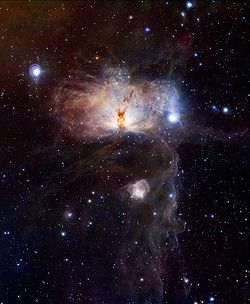NGC 2024
| NGC 2024 | |
 Foto av NGC 2024 taget med VISTA-teleskopet | |
| Observationsdata | |
|---|---|
| Typ | Emissionsnebulosa |
| Stjärnbild | Orion |
| Rektascension | 05t 41m 54s |
| Deklination | -01° 51′ 00″ |
| Avstånd | 900-1500 ljusår |
| Skenbar storlek | 30 × 30 bågminuter |
| Upptäckt | |
| Upptäcktsår | 1786 |
| Upptäckare | Wilhelm Herschel |
| Andra beteckningar | |
| Sharpless 2-277 | |
| Se även: Nebulosor, Lista över nebulosor | |
NGC 2024, eller Sh2-277, är en emissionsnebulosa som upptäcktes av Wilhelm Herschel 1786. Den är på 900 – 1500 ljusårs avstånd från jorden i stjärnbilden Orion.[1] Den ljusstarka stjärnan Alnitak (ζ Orionis), ingår i Orions bälte och är den stjärna som är längst till öster i bältet. Altinak är 100 000 gånger ljusstarkare än solen[2] och lyser upp nebulosan med en starkt ultraviolett ljus, vilket gett NGC 2024 namnet ”Flame Nebula” på engelska. Mörka gasmoln och stoft skymmer delar av nebulosan vilket orsakar det mörka nätverk som kan ses i centrum av nebulosan. NGC 2024 är en del i ett större stjärnbildningsområde i Orion, kallat Orion-komplexet, där också den berömda Hästhuvudnebulosan ingår.
Galleri
- Delar av Orions bälte och NGC 2024.
Referenser
- ^ ”NGC 2024”. SIMBAD Astronomical Database. http://simbad.u-strasbg.fr/simbad/sim-id?Ident=NGC+2024. Läst 7 augusti 2013.
- ^ Kaler, Jim. ”Altinak”. Stars by Professor Emeritus of Astronomy, University of Illinois. http://stars.astro.illinois.edu/sow/alnitak.html. Läst 7 augusti 2013.
Externa länkar
Media som används på denna webbplats
Flame Nebula (no border). "Atlas Image [or Atlas Image mosaic] obtained as part of the Two Micron All Sky Survey (2MASS), a joint project of the University of Massachusetts and the Infrared Processing and Analysis Center/California Institute of Technology, funded by the National Aeronautics and Space Administration and the National Science Foundation." seen here: http://www.ipac.caltech.edu/2mass/gallery/showcase/flameneb/index.html and here: http://antwrp.gsfc.nasa.gov/apod/ap990713.html
Författare/Upphovsman: ESO and Digitized Sky Survey 2, Licens: CC BY 4.0
This spectacular visible light wide-field view of part of the famous belt of the great celestial hunter Orion shows the region of the sky around the Flame Nebula. The whole image is filled with glowing gas clouds illuminated by hot blue young stars. It was created from photographs in red and blue light forming part of the Digitized Sky Survey 2. The field of view is approximately three degrees.
Författare/Upphovsman: ESO/IDA/Danish 1.5 m/R. Gendler, J.-E. Ovaldsen, C. Thöne and C. Féron, Licens: CC BY 4.0
Sparkling at the edge of a giant cloud of gas and dust, the Flame Nebula, also referred to as NGC 2024, is in fact the hideout of a cluster of young, blue, massive stars, whose light sets the gas ablaze. Located 1300 light-years away towards the constellation of Orion, the nebula owes its typical colour to the glow of hydrogen atoms, heated by the stars. The latter are obscured by a dark, forked dusty structure in the centre of the image and are only revealed by infra-red observations.
Colours & filters Band Wavelength Telescope
Optical B 433 nm Danish 1.54-metre telescope DFOSC Optical V 544 nm Danish 1.54-metre telescope DFOSC Optical R 648 nm Danish 1.54-metre telescope DFOSC.
Författare/Upphovsman: ESO/J. Emerson/VISTA. Acknowledgment: Cambridge Astronomical Survey Unit, Licens: CC BY 4.0
This VISTA image shows the spectacular star-forming region known as the Flame Nebula, or NGC 2024, in the constellation of Orion (the Hunter) and its surroundings. In views of this evocative object in visible light the core of the nebula is completely hidden behind obscuring dust, but in this VISTA view, taken in infra-red light, the cluster of very young stars at the object’s heart is revealed. The wide-field VISTA view also includes the glow of the reflection nebula NGC 2023, just below centre, and the ghostly outline of the Horsehead Nebula (Barnard 33) towards the lower right. The bright bluish star towards the right is one of the three bright stars forming the Belt of Orion. The image was created from VISTA images taken through J, H and Ks filters in the near-infrared part of the spectrum. The image shows the full area of the VISTA field and is one degree by 1.5 degrees in extent. The total exposure time was 14 minutes.






